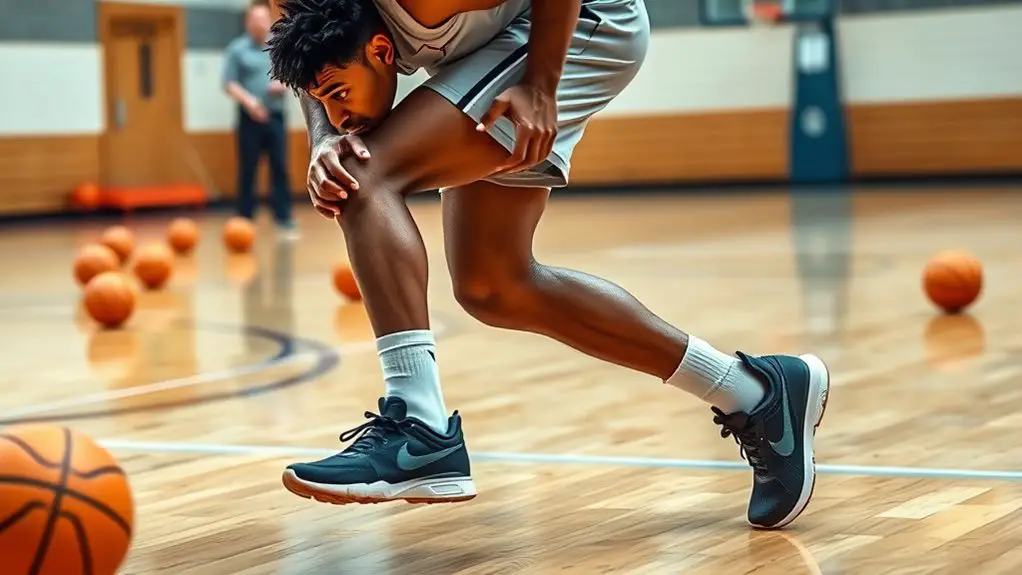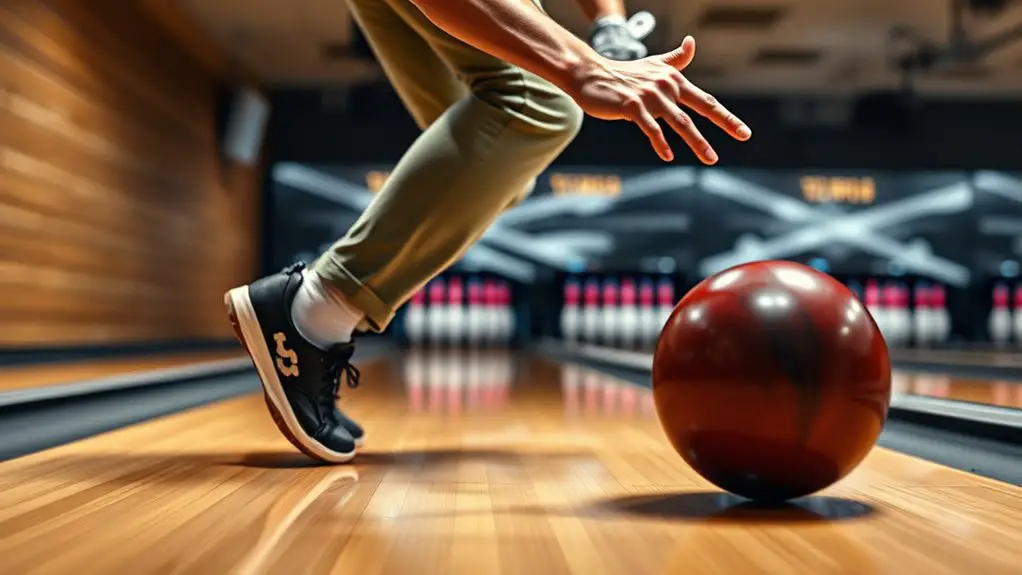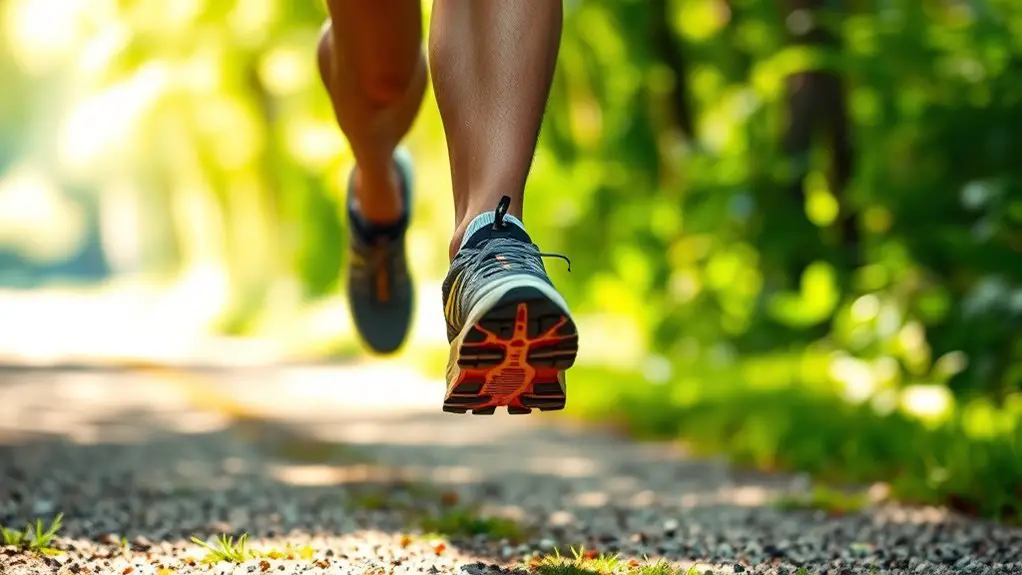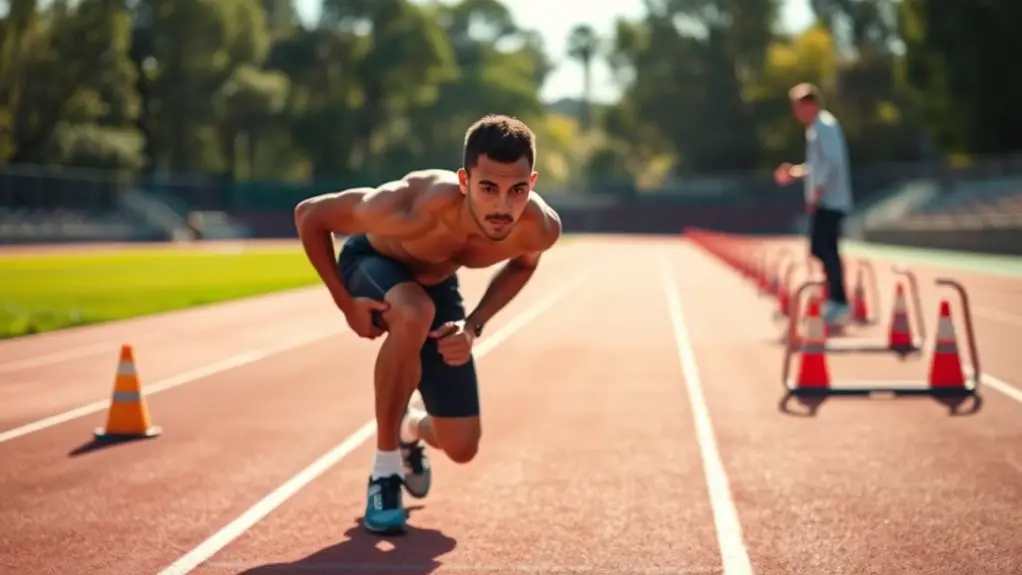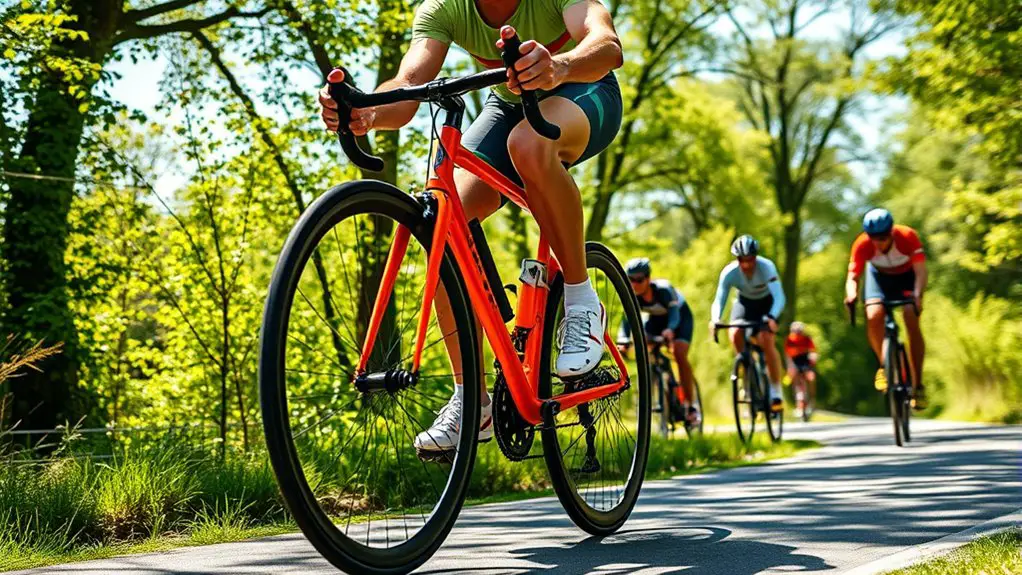To improve your lateral quickness for basketball defense, focus on specific drills like side shuffles, lateral bounds, and box drills. Work on your footwork by maintaining a low stance and using quick, small steps. Strength training, like squats and lunges, enhances your explosive movements and stability. Don't forget to track your progress to stay motivated. If you're keen on maximizing your performance, there are more effective strategies and techniques to explore next.
Understanding Lateral Quickness and Its Importance in Basketball Defense
Lateral quickness is essential for effective basketball defense, as it directly impacts your ability to stay in front of your opponent. When you master lateral movement, you gain the freedom to anticipate your rival's next move, allowing you to adjust your defensive positioning with ease. This agility helps you disrupt plays, create turnovers, and protect the basket.
Think about how often your opponent tries to drive past you or make a quick cut. If you can't move laterally with speed, you'll find it tough to maintain your defensive stance. By improving your lateral quickness, you can take control of the game, making it difficult for your opponent to exploit gaps in your defense. Remember, it's not just about being quick; it's about being smart in your movements. Embrace the challenge, and you'll find that your freedom on the court expands, making you a more formidable defender. Additionally, enhanced agility allows for quick responses to changing situations, further improving your effectiveness on defense.
Essential Drills to Enhance Lateral Quickness
Improving your lateral quickness requires targeted drills that focus on agility and movement. To get started, incorporate a mix of lateral drills and plyometric exercises into your routine. These will not only enhance your quickness but also keep your workouts dynamic and engaging. Additionally, strength training complements agility work by enhancing muscle power for directional changes.
| Drill | Description | Frequency |
|---|---|---|
| Side Shuffles | Shuffle side-to-side in a low stance | 3 sets of 30 sec |
| Lateral Bounds | Jump sideways, landing softly | 3 sets of 10 |
| Box Drills | Move in a box pattern, focusing on speed | 3 sets of 5 laps |
| Plyometric Skaters | Leap from side to side, using arms for momentum | 3 sets of 10 |
Techniques for Better Footwork and Agility
Effective footwork is essential for basketball defense, as it allows you to stay in front of your opponent and react swiftly. Mastering your foot positioning can dramatically enhance your lateral quickness. Here are some techniques to improve your agility on the court:
- Low Stance: Bend your knees and keep your hips low; this helps maintain balance and quick movement.
- Quick Steps: Use small, fast steps rather than long strides to adjust your position without losing speed.
- Pivoting: Practice pivoting on your inside foot to change direction quickly while keeping your body square to your opponent.
- Shadow Drills: Pair up with a partner and mimic their movements, focusing on your footwork and reaction time. Additionally, incorporating agility ladder drills into your training can significantly enhance your overall agility and coordination on the court.
Incorporating Strength Training for Improved Performance
While mastering footwork is essential, incorporating strength training can greatly enhance your overall defensive performance on the basketball court. By adding strength exercises to your routine, you'll not only boost your physical power but also improve your lateral quickness. Resistance training, like squats and lunges, builds the necessary muscle strength to help you push off the ground more explosively.
Incorporate exercises targeting your core, legs, and hips to develop stability and balance, vital for effective defensive maneuvers. You can also mix in plyometric drills, which combine strength and speed, allowing for quicker lateral movements. Additionally, performing Olympic lifts can further enhance your explosive power, enabling you to react faster on the court.
Moreover, don't forget about upper body strength; it aids in maintaining a strong defensive stance. As you regularly integrate these strength exercises into your training, you'll notice a significant improvement in your agility and overall defensive skills, giving you the freedom to move confidently on the court.
Tips for Maintaining Consistency and Progress Tracking
To achieve lasting improvements in your lateral quickness, it's crucial to maintain consistency in your training regimen and track your progress. Here are some tips to help you stay on course and evaluate your performance effectively:
- Set Clear Goals: Define specific, measurable goals for your lateral quickness, like completing drills in less time.
- Create a Training Schedule: Stick to a consistent training schedule, setting aside specific days for lateral quickness drills.
- Record Your Progress: Keep a journal or use an app to log your performance metrics—times, repetitions, and improvements.
- Regularly Reassess: Every few weeks, evaluate your performance to see how you're progressing toward your goals, adjusting your training as needed. Additionally, support systems play a significant role in maintaining motivation and commitment to your training efforts.
Frequently Asked Questions
How Does Nutrition Impact Lateral Quickness for Basketball Players?
Nutrition plays a vital role in your lateral quickness on the court. Carbohydrate timing is essential; fueling up with carbs before practice or games can boost your energy levels. Don't forget hydration strategies, too—staying well-hydrated keeps your muscles functioning effectively. If you give your body the right nutrients at the right times, you'll feel more agile and ready to move quickly, giving you the freedom to play your best.
What Role Does Flexibility Play in Improving Lateral Quickness?
Imagine a tree swaying effortlessly in the breeze—flexibility lets you move with similar grace. It's essential for improving lateral quickness. Incorporating dynamic stretching into your routine readies your muscles for agility training, allowing you to shift direction swiftly. When you're flexible, your body responds better, giving you the freedom to glide across the court. Embrace flexibility, and you'll find your movements become fluid, enhancing your overall performance and defensive skills.
Can Age Affect an Athlete's Lateral Quickness?
Yes, age can affect your lateral quickness. As you age, the body experiences changes that may slow down your reactions and reduce agility. However, with the right training adaptations, you can maintain or even improve your quickness. Incorporating flexibility and strength training into your routine can counteract aging effects, allowing you to stay quick and agile. Embracing this journey not only keeps you active but also gives you the freedom to move with confidence.
Are There Specific Shoes Recommended for Better Lateral Movement?
When you're looking for shoes to enhance your lateral movement, focus on specific shoe features that provide support and stability. Look for designs with a low profile and a snug fit to keep your foot secure. Traction types matter too; you'll want rubber outsoles with multidirectional patterns for grip. This combo will give you the freedom to move quickly and efficiently, helping you stay agile on the court without feeling restricted.
How Often Should I Practice Lateral Quickness Drills?
When it comes to lateral drills frequency, aim for two to three times a week. This keeps your training schedule balanced, allowing for recovery while still building your quickness. Don't overdo it; your body needs time to adapt. Mix in various drills to keep it engaging and fun. Remember, consistency is key, but so is enjoying your practice. Find that rhythm, and you'll see improvements while still feeling free on the court!
